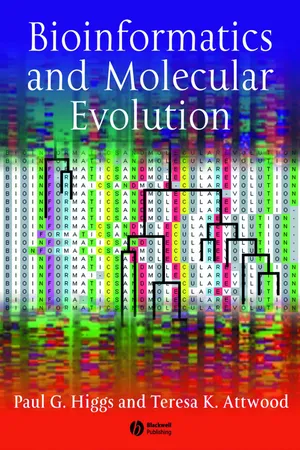Biological Sciences
Neutral Mutations
Neutral mutations are genetic changes that do not have a significant impact on an organism's fitness or survival. These mutations typically occur in non-coding regions of the genome or result in amino acid substitutions that do not affect the function of the protein. As a result, they are often considered to be evolutionarily neutral and may accumulate in a population over time.
Written by Perlego with AI-assistance
Related key terms
4 Key excerpts on "Neutral Mutations"
- eBook - ePub
Advanced Molecular Biology
A Concise Reference
- Richard Twyman(Author)
- 2018(Publication Date)
- Garland Science(Publisher)
Such mutations are described as being selectively neutral because they do not influence the Darwinian fitness of the individual; they include most extragenic mutations. Most mutations which have a phenotypic consequence fall within genes or the regulatory elements which control them. There are three different target sequences for such mutations: the coding region of the gene, noncoding sequences within the transcription unit, and regulatory sequences outside the transcription unit. Many point mutations within genes are neutral because they do not alter either the structure or expression of the encoded product (see Table 15.2). Point mutations which do modify the gene product or its expression in some way are usually deleterious or neutral — a few may be beneficial, but this depends on the selective constraints on the structure of the polypeptide and the environment in which the polypeptide functions (q.v. natural selection, molecular clock). Macromutations occurring within genes or involving genes are generally deleterious because they cause large-scale disruptions (see Table 15.3). The consequences of many different types of mutation are exemplified by the study of hemoglobin disorders (Box 15.1). Whatever the consequences of a mutation per se, whether these effects are expressed at the level of the phenotype depends on several additional factors. (1) Dominance. In diploids, the mutant allele may be recessive to the wild-type allele and its effects will not manifest in the heterozygote. (2) Genetic background and environment. The mutant allele may not be penetrant even in the homozygous state if its. effects can be compensated by nonallelic interactions (e.g. redundant genes, external suppressor mutations) or by environmental factors (e.g - eBook - ePub
- David Baum, Douglas Futuyma, Hopi Hoekstra, Richard Lenski, Allen Moore, Cahterine Peichel, Dolph Schluter, Michael Whitlock(Authors)
- 2013(Publication Date)
- Princeton University Press(Publisher)
all new mutations, be they deleterious, neutral, or adaptive, are lost and lost quickly.2. THE NEUTRAL THEORY OF MOLECULAR EVOLUTIONTo detect adaptation with confidence, much more specific, quantitative expectations under the null model of no adaptation must be generated. The neutral theory, most commonly associated with Motoo Kimura, provides a good example of such expectations (see chapter V.1 ). The neutral theory postulates that practically all mutations are either deleterious or neutral and that practically all detectable polymorphisms and all substitutions are due to Neutral Mutations. Note that the second postulate is much more restrictive than the first. Even if the adaptive mutations are vanishingly rare compared with neutral or deleterious mutations, they still could easily contribute to the majority of substitutions. This is because the probability of fixation of a new neutral mutation is the reciprocal of the population size (N) (technically of the long-term effective population size Ne ), while the probability of fixation of a strongly advantageous mutation is roughly equal to its selective benefit (as mentioned above) and the latter can be much, much larger. For instance, in Drosophila melanogaster, where the (long-term effective) population size is roughly 1 million, a mutation that provides 1 percent benefit has a 10,000 times greater chance of fixation than a neutral mutation. This implies that if adaptive mutations of 1 percent advantage were even 1000 times less frequent than neutral ones, they would still correspond to about 90 percent of all substitutions. The neutral theory thus claims that the increased chance of fixation of adaptive mutations does not compensate for their relative rarity.Figure 1. Expected patterns of polymorphism (P) and divergence (D) and functional (subscript n) and neutral (subscript s) sites. (A) The expectation under the neutral theory. Mutations at functional sites come in two classes, either lethal - eBook - ePub
- Paul G. Higgs, Teresa K. Attwood(Authors)
- 2013(Publication Date)
- Wiley-Blackwell(Publisher)
In other words, it is the similarities of sequences between organisms that strikes one first, rather than the specializations. Thus, it seems reasonable to conclude that sequences diverge despite the action of stabilizing selection that is trying to keep them the same. Neutralists therefore argue that it is mutation that is the dominant force driving the divergence between sequences, and that most of the differences we see between sequences in different species are the result of fixation of nearly Neutral Mutations by chance in one or other lineage. King and Jukes (1969) produced an influential paper arguing for the importance of neutrality, and the neutral theory has famously been developed and championed by Kimura (1983). There has since been a lot of criticism from adaptationists, who dislike the apparently large role of chance in neutral evolution. It is nevertheless important to understand exactly what the neutral hypothesis says. Neutralists do not deny that selection happens. They recognize the role of stabilizing selection in removing deleterious mutations, and recognize that occasionally advantageous mutations must occur. However, they argue that (nearly) Neutral Mutations are much more frequent than advantageous ones, and hence that the majority of mutations that manage to become fixed in a population are neutral. Advantageous mutations are hard to spot because they spread rapidly through a population and it is difficult to catch one in the act. Once the mutation has gone to fixation, there will be no variability remaining in this part of the sequence. This is called a selective sweep. When the advantageous mutation goes to fixation, it may cause other mutations at closely linked points in the sequence to hitch-hike to fixation at the same time. The other mutations may be neutral or even slightly disadvantageous - eBook - ePub
- Mark Stoneking(Author)
- 2016(Publication Date)
- Wiley-Blackwell(Publisher)
So we end up with the surprising result that the rate of neutral evolution is simply equal to the neutral mutation rate. We'll discuss neutral evolution (and other aspects of molecular evolution) later on in Chapter 6, but there is one further point to make here: note that the rate does not depend at all on population size, which may seem counterintuitive. The reason is that in a small population, there are fewer new mutations occurring each generation, but fixation goes more quickly. Conversely, in a big population, there are more new mutations occurring each generation but fixation takes longer. Remarkably, these two processes balance each other exactly, so the overall rate of neutral evolution is the same regardless of the population size.Figure 5.8 shows the overall process of neutral evolution in a population. New mutations arise (2Nμ of them every generation), of which the vast majority are lost via genetic drift. But on average every 1/μ generations a new mutation will keep rising in frequency and reach fixation. How long does it take a mutation that is going to be fixed to reach fixation? The derivation of this result is too complex to go into, so I will just tell you the answer: it takes on average 4N generations for the fixation to occur, which hopefully makes sense, as the larger the population, the longer it takes for fixation to occur.Figure 5.8Fixation of Neutral Mutations. In a large population (top), many mutations occur but only a few rise to fixation. In a small population (bottom), fewer mutations occur, but more of them rise to fixation. Overall, the rate of fixation of Neutral Mutations is independent of population size.Finally, what is the effect of mutation on genetic variation within populations, and genetic differences between populations? Hopefully, this is an easy one for you. Mutation increases genetic variation within populations, as new alleles are continually being generated. And since the mutations that occur in one population are different from those in another population, mutation increases the genetic differences between populations. But keep in mind that when it comes to changing existing allele frequencies in a population, mutation takes a back seat to all of the other evolutionary forces discussed in this chapter.
Learn about this page
Index pages curate the most relevant extracts from our library of academic textbooks. They’ve been created using an in-house natural language model (NLM), each adding context and meaning to key research topics.



